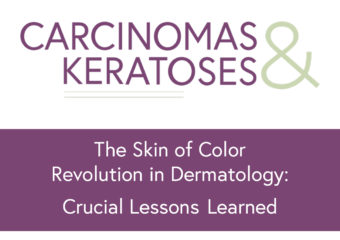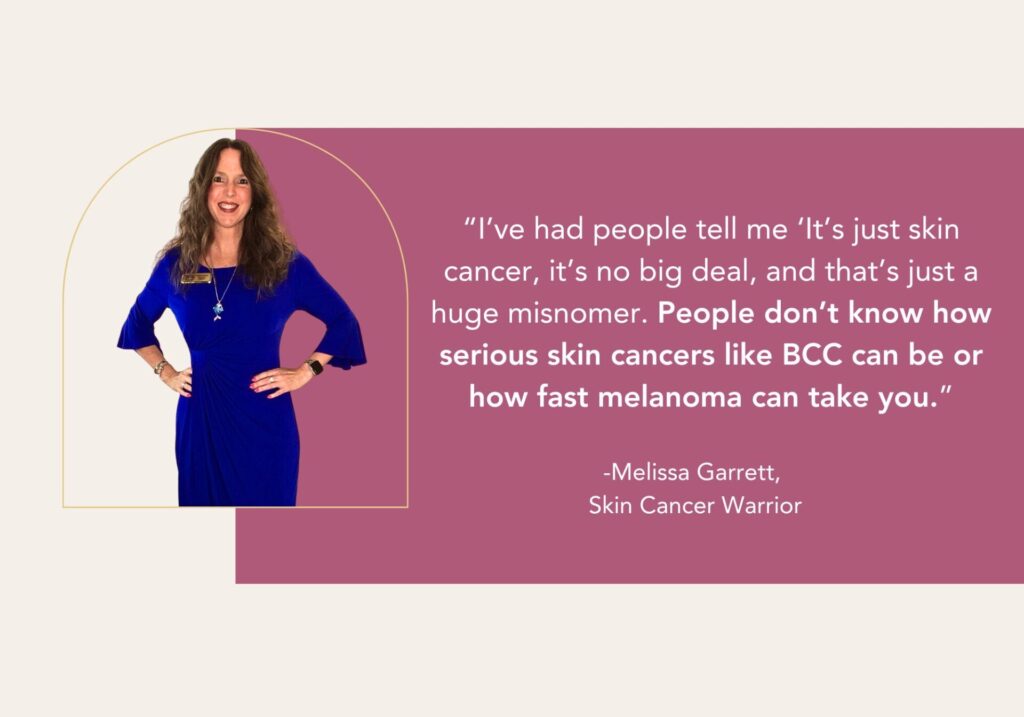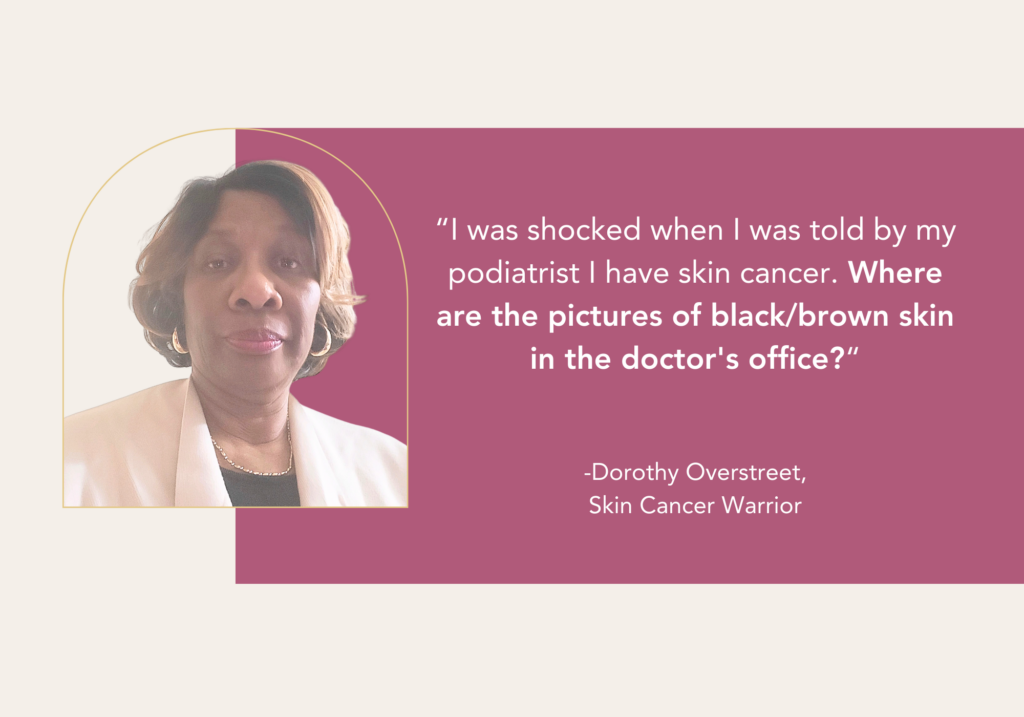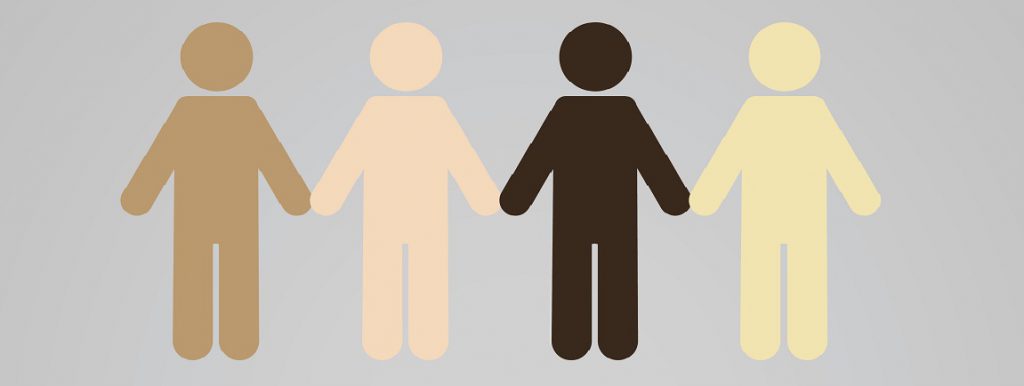Skin Cancer in Skin of Color
Anyone Can Get Skin Cancer. Know the Warning Signs.
It’s a fact: Skin cancer affects people of all colors.
- Even if you have a darker skin tone, always tan or rarely burn, you can still develop the disease.
- This includes people of African, Asian, Latino, Mediterranean, Middle Eastern and Native American descent.
- For people of color, skin cancer is often diagnosed later, when it is harder to treat.
Simply put, if you have skin, you can get skin cancers like basal cell carcinoma (BCC), squamous cell carcinoma (SCC) and melanoma. Furthermore, ultraviolet (UV) radiation from the sun can cause dangerous, lasting damage to your skin, no matter its tone.
What You Can Do: Know the Warning Signs
The most important thing to do is get to know your skin type and protect your skin from the sun. Also, understand the skin cancer warning signs, what to look for, and where to look. Skin cancer on darker skin often occurs on areas that get little sun exposure, like the palms of hands, soles of feet, under and around the nails. Check yourself monthly and get a full body skin exam at least once a year. And if you notice anything NEW, CHANGING or UNUSUAL on your skin, contact a dermatologist right away.
Join the #LoveYourSkin Campaign
To raise awareness about the dangers of skin cancer, we invite you to join our public awareness campaign — #LoveYourSkin — focused on skin cancer education, early detection and sun protection for skin of color.
It’s easy to get involved:
- Follow us on social media
- Share posts, facts and graphics to help spread the word (see below for downloadable graphics to share)
- Use the hashtag #LoveYourSkinProtectYourSkin and tag us @SkinCancerOrg so we can amplify the message
Together, we can help one another, share the facts and the love. Because loving your skin means protecting your skin.
Download the PDFs:
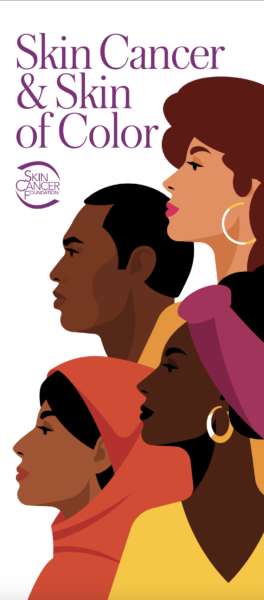
Intended only for personal use. Do not copy or distribute. To purchase the brochure, visit store.SkinCancer.org.
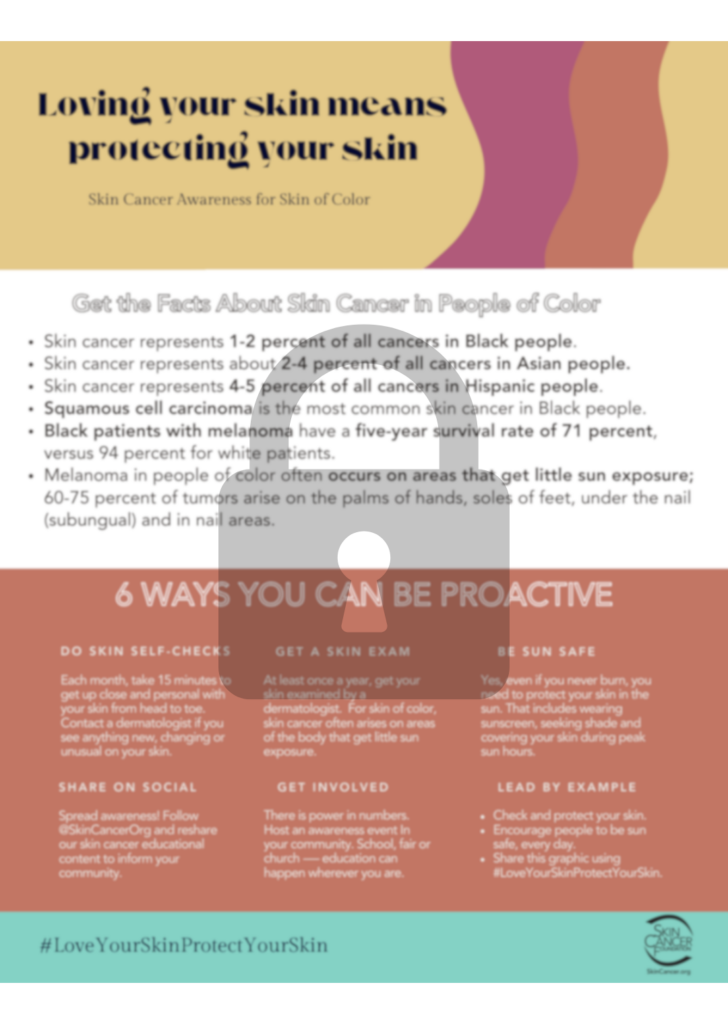
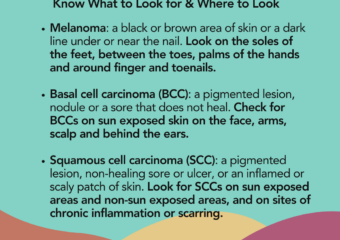
Skin of Color Stats & Downloadable Content
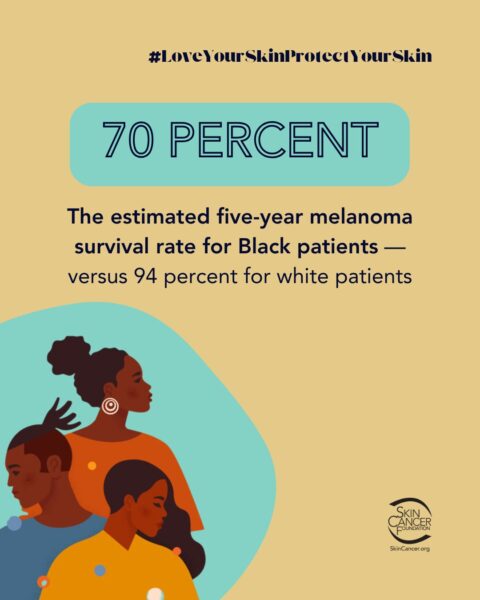
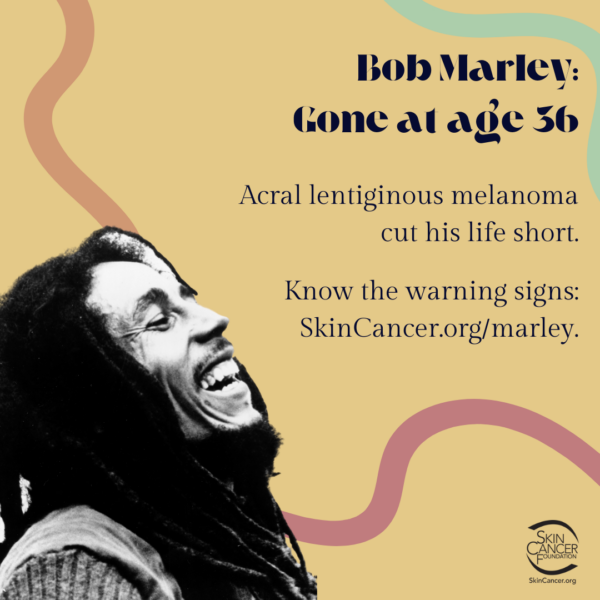
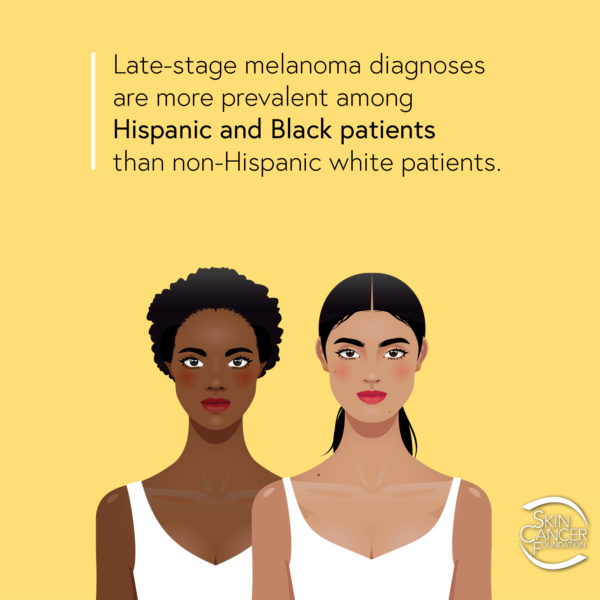
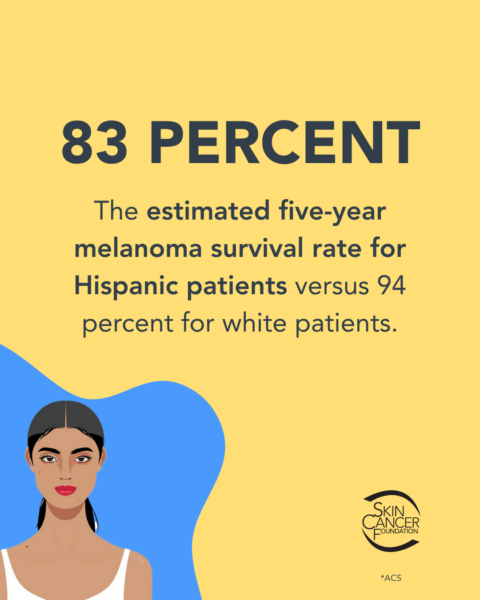
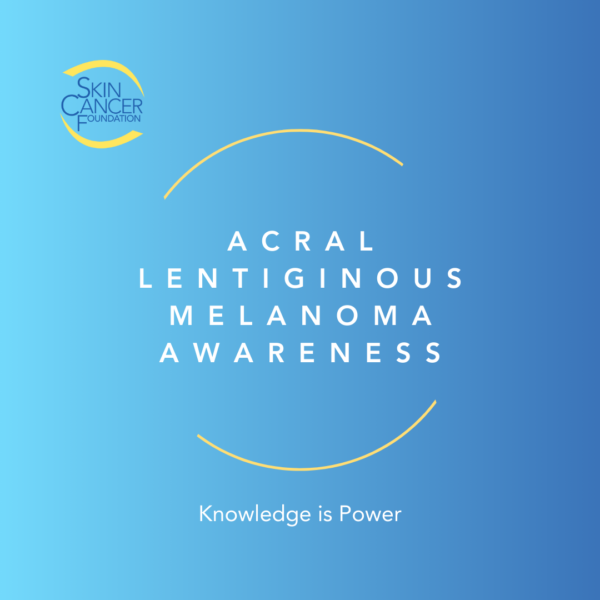
- Skin cancer represents 1 to 2 percent of all cancers in Black people.2
- Skin cancer represents approximately 2 to 4 percent of all cancers in Asian people.2
- Skin cancer represents 4 to 5 percent of all cancers in Hispanic people.3
- Squamous cell carcinoma is the most common skin cancer in Black people.2
- Black patients with melanoma have an estimated five-year melanoma survival rate of 70 percent, versus 94 percent for white patients.1
- Melanoma in people of color most often occurs on areas that get little sun exposure. Up to 60 to 75 percent of tumors arise on the palms of the hands, soles of the feet under the nail (subungual) and the nail areas. 2
- Black patients are more than three times as likely to be diagnosed with melanoma at a late stage than non-Hispanic white patients. 52 percent of non-Hispanic Black patients and 26 percent of Hispanic patients receive an initial diagnosis of advanced-stage melanoma, versus 16 percent of non-Hispanic white patients.4
- In people of color, the plantar portion of the foot is often the most common site of skin cancer, being involved in 30 to 40 percent of cases.3
- People of color have higher percentages of acral lentiginous melanoma (ALM, melanoma of the palms, soles and nailbeds) than Caucasians. Superficial spreading melanoma is the most frequent subtype in Caucasians and Hispanics.3
Click for references
- Cancer Facts and Figures 2025. American Cancer Society. https://www.cancer.org/content/dam/cancer-org/research/cancer-facts-and-statistics/annual-cancer-facts-and-figures/2025/2025-cancer-facts-and-figures-acs.pdf Accessed January 21, 2025.
- Gloster HM, Neal K. Skin cancer in skin of color. J Am Acad Dermatol 2006; 55:741-60.
- Bradford, Porcia T. Skin Cancer in Skin of Color. Dermatol Nurs 2009 Jul-Aug; 21(4): 170-178.
- Hu S, Soza-Vento RM, Parker DF, et al. Comparison of stage at diagnosis of melanoma among Hispanic, black, and white patients in Miami-Dade County, Florida. Arch Dermatol 2006; 142(6):704-8.
Bob Marley was diagnosed with acral lentiginous melanoma (ALM) which ultimately claimed his life in 1981 at age 36. When a dark spot appeared under his toenail, Marley attributed it to a soccer injury. Eventually he was diagnosed with the disease but refused the recommended treatment. His melanoma spread to other areas of his body and tragically cut his life short.
Ask the Expert
Q: While all types of skin cancer are less common in people of color, their outcomes are dramatically worse. What accounts for this gap?
A: Skin cancers are less prevalent in nonwhite racial ethnic groups, but when they occur, they tend to be diagnosed at a later stage. As a result, the prognosis is worse. One study showed that late-stage melanoma diagnoses are more common in Hispanic and Black patients than in non-Hispanic white patients.
First, there’s a lower public awareness of the risk of skin cancer among individuals of color. Second, from the perspective of health-care providers, there’s often a lower index of suspicion for skin cancer in patients of color. This is because the chances of it are smaller. So these patients may be less likely to get regular, full-body skin exams. And third, the places on the body where skin cancers tend to occur in people of color are often in less sun-exposed areas. This makes detection more difficult. For example, the most common location for melanoma in patients of color is the lower extremities — the soles of the feet in particular. Day in and day out, patients are shocked to learn that you can get a melanoma on your foot, in your nailbed (subungual melanoma) in your eyes or some other place that seems protected from the sun.[Read full blog post: Is There a Skin Cancer Crisis in People of Color?]
– Andrew Alexis, MD, MPH, is chair of the Department of Dermatology at Mount Sinai St. Luke’s and Mount Sinai West in New York City.
Images
Please note: Since not all skin cancers have the same appearance, these images serve as a general reference to what it may look like.
ACRAL LENTIGINOUS MELANOMA
Acral lentiginous melanoma (ALM) is the most common melanoma found in people of color.
 Photo credit: Hugh Gloster, MD
Photo credit: Hugh Gloster, MD

Stage II acral lentiginous melanoma on left heel. Photo courtesy of: Dorothy Overstreet

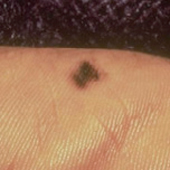

Melanoma on the lip of a Black man

Nodular melanoma on the leg of a Native American woman.
Photos: International Skin Imaging Collaboration
BASAL CELL CARCINOMA
A basal cell carcinoma (BCC) may be pigmented, like this one, on skin of color.
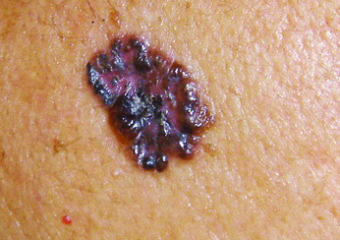 Photo: Andrew Alexis, MD, MPH
Photo: Andrew Alexis, MD, MPH
Pigmented BCC
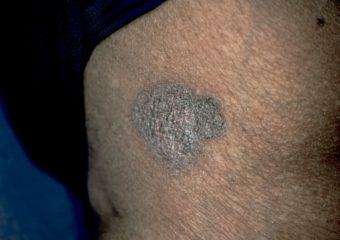 Photo: Hugh Gloster, MD
Photo: Hugh Gloster, MD
Pigmented BCC behind the ear
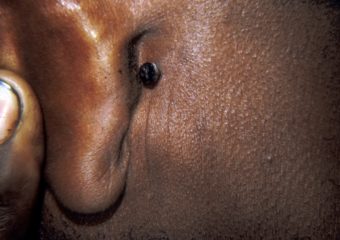 Photo: Hugh Gloster, MD
Photo: Hugh Gloster, MD
BCC on the nose of an Asian man
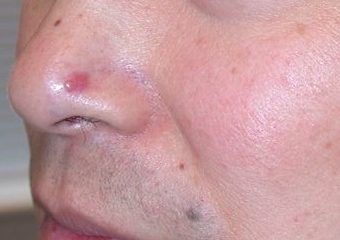 Photo: Hugh Gloster, MD
Photo: Hugh Gloster, MD
SQUAMOUS CELL CARCINOMA
Squamous cell carcinoma (SCC) on the scalp of a Black man.
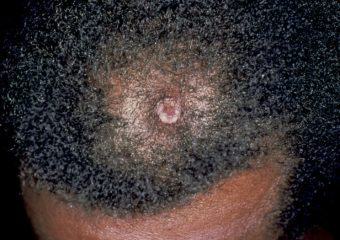 Photo: Hugh Gloster, MD
Photo: Hugh Gloster, MD
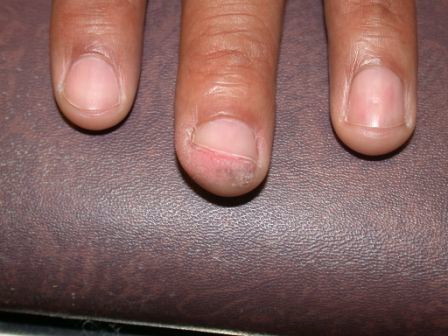
Bowen’s disease (SCC in situ) on the finger of a Black man

